One-Stage Formation of Two-Dimensional Photonic Crystal and Spatially Ordered Arrays of Self-Assembled Ge(Si) Nanoislandson Pit-Patterned Silicon-On-Insulator Substrate
Abstract
:1. Introduction
2. Materials and Methods
3. Results and Discussion
3.1. MC Simulation of Heteroepitaxial Growth of Ge on a Pit-Patterned Si(001) Surface
3.2. Formation of an Array of Spatially Ordered Ge(Si) QDs
3.3. Luminescent Properties of the Structures with Ordered Ge(Si) QDs
4. Conclusions
Supplementary Materials
Author Contributions
Funding
Institutional Review Board Statement
Informed Consent Statement
Acknowledgments
Conflicts of Interest
References
- Vahala, K.J. Optical microcavities. Nature 2003, 424, 839–846. [Google Scholar] [CrossRef] [PubMed]
- Hirose, K.; Liang, Y.; Kurosaka, Y.; Watanabe, A.; Sugiyama, T.; Noda, S. Watt-class high-power, high-beam-quality photonic-crystal lasers. Nat. Photonics 2014, 8, 406–411. [Google Scholar] [CrossRef]
- Staude, I.; Schilling, J. Metamaterial-inspired silicon nanophotonics. Nat. Photonics 2017, 11, 274–284. [Google Scholar] [CrossRef]
- Bidault, S.; Mivelle, M.; Bonod, N. Dielectric nanoantennas to manipulate solid state light emission. J. Appl. Phys. 2019, 126, 094104. [Google Scholar] [CrossRef]
- Vaskin, A.; Kolkowski, R.; Koenderink, A.F.; Staude, I. Light-emitting metasurfaces. Nanophotonics 2019, 8, 1151–1198. [Google Scholar] [CrossRef]
- Baranov, D.G.; Zuev, D.A.; Lepeshov, S.I.; Kotov, O.V.; Krasnok, A.E.; Evlyukhin, A.B.; Chichkov, B.N. All-dielectric nanophotonics: The quest for better materials and fabrication techniques. Optica 2017, 4, 814–825. [Google Scholar] [CrossRef]
- Kasper, E. Group IV heteroepitaxy on silicon for photonics. J. Mater. Res. 2016, 31, 3639–3648. [Google Scholar] [CrossRef]
- Brehm, M.; Grydlik, M. Site-controlled and advanced epitaxial Ge/Si quantum dots: Fabrication, properties, and applications. Nanotechnology 2017, 28, 392001. [Google Scholar] [CrossRef]
- Zhou, Z.; Yin, B.; Michel, J. On-chip light sources for silicon photonics. Light Sci. Appl. 2015, 4, e358. [Google Scholar] [CrossRef]
- Leitao, J.P.; Santos, N.M.; Sobolev, N.A.; Correia, M.R.; Stepina, N.P.; Carmo, M.C.; Magalhaes, S.; Alves, E.; Novikov, A.V.; Shaleev, M.V.; et al. Radiation hardness of GeSiheterostructures with thin Ge layers. Mater. Sci. Engin. B 2008, 147, 191–194. [Google Scholar] [CrossRef] [Green Version]
- Novikov, A.V.; Yablonskiy, A.N.; Platonov, V.V.; Obolenskiy, S.V.; Lobanov, D.N.; Krasilnik, Z.F. Effect of irradiation on the luminescence properties of low-dimensional SiGe/Si(001) heterostructures. Semiconductors 2010, 44, 329–334. [Google Scholar] [CrossRef]
- Apertz, R.; Vescan, L.; Hartmann, A.; Dieker, C.; Luth, H. Photoluminescence and electroluminescence of SiGe dots fabricated by island growth. Appl. Phys. Lett. 1995, 66, 445–447. [Google Scholar] [CrossRef]
- Vescan, L.; Stoica, T.; Chretien, O.; Goryll, M.; Mateeva, E.; Muck, A. Size distribution and electroluminescence of self-assembled Ge dots. J. Appl. Phys. 2000, 87, 7275–7282. [Google Scholar] [CrossRef] [Green Version]
- Tonkikh, A.A.; Cirlin, G.E.; Talalaev, V.G.; Zakharov, N.D.; Werner, P. Room temperature electroluminescence from multilayer GeSiheterostructures. Phys. Stat. Sol. (A) 2006, 203, 1390–1394. [Google Scholar] [CrossRef]
- Zeng, C.; Ma, Y.; Zhang, Y.; Li, D.; Huang, Z.; Wang, Y.; Huang, Q.; Li, J.; Zhong, Z.; Yu, J.; et al. Single germanium quantum dot embedded in photonic crystal nanocavity for light emitter on silicon chip. Opt. Express 2015, 23, 22250–22260. [Google Scholar] [CrossRef]
- Schatzl, M.; Hackl, F.; Glaser, M.; Rauter, P.; Brehm, M.; Spindlberger, L.; Simbula, A.; Galli, M.; Fromherz, T.; Schäffler, F. Enhanced telecom emission from single group-IV quantum dots by precise CMOS-compatible positioning in photonic crystal cavities. ACS Photonics 2017, 4, 665–673. [Google Scholar] [CrossRef]
- Hsu, C.W.; Zhen, B.; Stone, A.D.; Joannopoulos, J.D.; Soljačic, M. Bound states in the continuum. Nat. Rev. Mater. 2016, 1, 16048. [Google Scholar] [CrossRef] [Green Version]
- Liu, Z.; Xu, Y.; Lin, Y.; Xiang, J.; Feng, T.; Cao, Q.; Li, J.; Lan, S.; Liu, J. High-Q Quasibound States in the Continuum for nonlinear metasurfaces. Phys. Rev. Lett. 2019, 123, 253901. [Google Scholar] [CrossRef] [Green Version]
- Jannesari, R.; Schatzl, M.; Hackl, F.; Glaser, M.; Hingerl, K.; Fromherz, T.; Schäffler, F. Commensurate germanium light emitters in silicon-on-insulator photonic crystal slabs. Opt. Express 2014, 22, 25426–25435. [Google Scholar] [CrossRef]
- Smagina, Z.V.; Novikov, A.V.; Stepikhova, M.V.; Zinovyev, V.A.; Rodyakina, E.E.; Nenashev, A.V.; Sergeev, S.M.; Peretokin, A.V.; Kuchinskaya, P.A.; Shaleev, M.V.; et al. Luminescence of spatially ordered self-assembled solitary Ge(Si) nanoislands and their groups incorporated into photonic crystals. Semiconductors 2020, 54, 853–859. [Google Scholar] [CrossRef]
- Kiravittaya, S.; Rastelli, A.; Schmidt, O.G. Advanced quantum dot configurations. Rep. Prog. Phys. 2009, 72, 1–34. [Google Scholar] [CrossRef]
- Ratto, F.; Rosei, F. Order and disorder in the heteroepitaxy of semiconductor nanostructures. Mater. Sci. Eng. R 2010, 70, 243–264. [Google Scholar] [CrossRef]
- Smagina, Z.V.; Zinovyev, V.A.; Rodyakina, E.E.; Fomin, B.I.; Stepikhova, M.V.; Yablonskiy, A.N.; Gusev, S.A.; Novikov, A.V.; Dvurechenskii, A.V. Ordered arrays of Ge(Si) quantum dots incorporated into two-dimensional photonic crystals. Semiconductors 2019, 53, 1329–1333. [Google Scholar] [CrossRef]
- Novikov, P.L.; Nenashev, A.V.; Rudin, S.A.; Polyakov, A.S.; Dvurechenskii, A.V. Simulating the nucleation and growth of Ge quantum dots on Si using high-efficiency algorithms. Nanotechnol. Russ. 2015, 10, 192–204. [Google Scholar] [CrossRef]
- Keating, P.N. Effect of invariance requirements on the elastic strain energy of crystals with application to the diamond structure. Phys. Rev. 1966, 145, 637–645. [Google Scholar] [CrossRef]
- Smagina, Z.V.; Zinovyev, V.A.; Krivyakin, G.K.; Rodyakina, E.E.; Kuchinskaya, P.A.; Fomin, B.I.; Yablonskiy, A.N.; Stepikhova, M.V.; Novikov, A.V.; Dvurechenskii, A.V. Study of the structural and emission properties of Ge(Si) quantum dots ordered on the Si(001) surface. Semiconductors 2018, 52, 1150–1155. [Google Scholar] [CrossRef]
- Kienzle, O.; Ernst, F.; Rühle, M.; Schmidt, O.G.; Eberl, K. Germanium “quantum dots” embedded in silicon: Quantitative study of self-alignment and coarsening. Appl. Phys. Lett. 1999, 74, 269. [Google Scholar] [CrossRef]
- Tikhodeev, S.G.; Yablonskii, A.L.; Muljarov, E.A.; Gippius, N.A.; Ishihara, T. Quasiguided modes and optical properties of photonic crystal slabs. Phys. Rev. B 2002, 66, 045102. [Google Scholar] [CrossRef] [Green Version]
- Moharam, M.; Gaylord, T.; Grann, E.B.; Pommet, D.A. Formulation for stable and efficient implementation of the rigorous coupled-wave analysis of binary gratings. J. Opt. Soc. Am. A 1995, 12, 1068. [Google Scholar] [CrossRef]
- Smagina, Z.V.; Zinovyev, V.A.; Rudin, S.A.; Novikov, P.L.; Rodyakina, E.E.; Dvurechenskii, A.V. Nucleation sites of Genanoislands grown on pit-patterned Si substrate prepared by electron-beam lithography. J. Appl. Phys. 2018, 123, 165302. [Google Scholar] [CrossRef]
- Vastola, G.; Grydlik, M.; Brehm, M.; Fromherz, T.; Bauer, G.; Boioli, F.; Miglio, L.; Montalenti, F. How pit facet inclination drives heteroepitaxial island positioning on patterned substrates. Phys. Rev. B 2011, 84, 155415. [Google Scholar] [CrossRef]
- Dais, C.; Mussler, G.; Sigg, H.; Müller, E.; Solak, H.H.; Grützmacher, D. Evolution and stability of ordered SiGe islands grown on patterned Si(100) substrates. J. Appl. Phys. 2009, 105, 122405. [Google Scholar] [CrossRef] [Green Version]
- Dyakov, S.A.; Zhigunov, D.M.; Marinins, A.; Shalygina, O.A.; Vabishchevich, P.P.; Shcherbakov, M.R.; Presnov, D.E.; Fedyanin, A.A.; Kashkarov, P.K.; Popov, S.; et al. Plasmon induced modification of silicon nanocrystals photoluminescence in presence of gold nanostripes. Sci. Rep. 2018, 8, 1–10. [Google Scholar] [CrossRef]
- Rudin, S.A.; Smagina, Z.V.; Zinovyev, V.A.; Novikov, P.L.; Nenashev, A.V.; Rodyakina, E.E.; Dvurechenskii, A.V. Nucleation of three-dimensional Ge islands on a patterned Si(100) surface. Semiconductors 2018, 52, 1457–1461. [Google Scholar] [CrossRef]
- Tersoff, J.; Spencer, B.J.; Rastelli, A.; von Kanel, H. Barrierless Formation and Faceting of SiGe Islands on Si(001). Phys. Rev. Lett. 2002, 89, 196104. [Google Scholar] [CrossRef]
- Rastelli, A.; von Kanel, H.; Spencer, B.J.; Tersoff, J. Prepyramid-to-pyramid transition of SiGe islands on Si(001). Phys. Rev. B 2003, 68, 115301. [Google Scholar] [CrossRef] [Green Version]
- Novikov, A.V.; Andreev, B.A.; Vostokov, N.V.; Drozdov, Y.N.; Krasil’nik, Z.F.; Lobanov, D.N.; Moldavskaya, L.D.; Ya-blonskiy, A.N.; Miura, M.; Usami, N.; et al. Strain-driven alloying: Effect on sizes, shape and photoluminescence of GeSi/Si(001) self-assembled islands. Mater. Sci. Eng. B 2002, 89, 62. [Google Scholar] [CrossRef]
- Chaparro, S.A.; Drucker, J.; Zhang, Y.; Chandrasekhar, D.; McCartney, M.R.; Smith, D.J. Strain-driven alloying in Ge/Si(001) coherent islands. Phys. Rev. Lett. 1999, 83, 1199. [Google Scholar] [CrossRef]
- Hackl, F.; Grydlik, M.; Brehm, M.; Groiss, H.; Schaffler, F.; Fromherz, T.; Bauer, G. Microphotoluminescence and perfect or-dering of SiGe islands on pit-patterned Si(001) substrates. Nanotechnology 2011, 22, 165302. [Google Scholar] [CrossRef]
- Johnson, S.G.; Fan, S.; Villeneuve, P.R.; Joannopoulos, J.D.; Kolodziejski, L.A. Guided modes in photonic crystal slabs. Phys. Rev. B 1999, 60, 5751–5758. [Google Scholar] [CrossRef] [Green Version]
- Dyakov, S.A.; Stepikhova, M.V.; Bogdanov, A.A.; Novikov, A.V.; Yurasov, D.V.; Krasilnik, Z.F.; Tikhodeev, S.G.; Gippius, N.A. Photonic bound states in the continuum in Si structures with the self-assembled Genanoislands. arXiv 2020, arXiv:2006.06086. [Google Scholar]
- Stepikhova, M.V.; Novikov, A.V.; Yablonskiy, A.N.; Shaleev, M.V.; Utkin, D.E.; Rutckaia, V.V.; Skorokhodov, E.V.; Sergeev, S.M.; Yurasov, D.V.; Krasilnik, Z.F. Light emission from Ge(Si)/SOI self-assembled nanoislands embedded in photonic crystal slabs of various period with and without cavities. Semicond. Sci. Technol. 2019, 34, 024003. [Google Scholar] [CrossRef]
- Vostokov, N.V.; Drozdov, Y.N.; Krasil’nik, Z.F.; Lobanov, D.N.; Novikov, A.V.; Yablonskii, A.N. Low-energy photoluminescence of structures with GeSi/Si(001) self-assembled nanoislands. JETP Lett. 2002, 76, 365–369. [Google Scholar] [CrossRef]
- Xu, X.; Chiba, T.; Nakama, T.; Maruizumi, T.; Shiraki, Y. High-quality-factor light-emitting diodes with modified photonic crystal nanocavities including Ge self-assembled quantum dots on silicon-on-insulator substrates. Appl. Phys. Express 2012, 5, 102101. [Google Scholar] [CrossRef]
- Xia, J.; Maruizumi, T.; Shiraki, Y. Ge quantum dots light-emitting devices. Front. Optoelectron. 2012, 5, 13. [Google Scholar] [CrossRef]
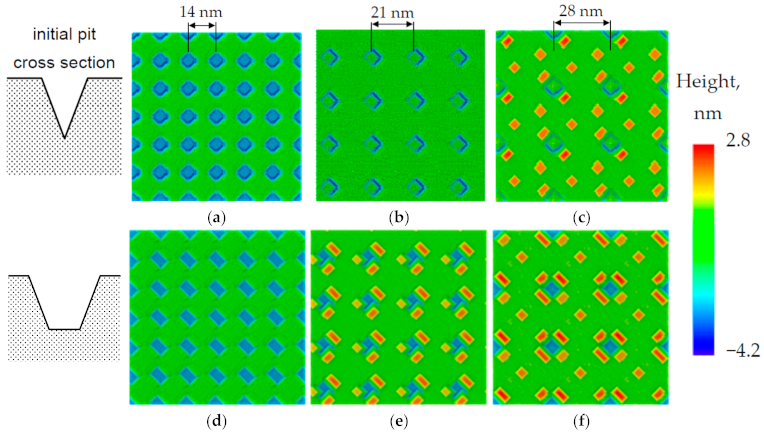
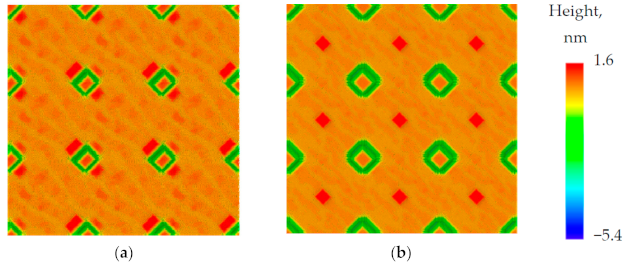
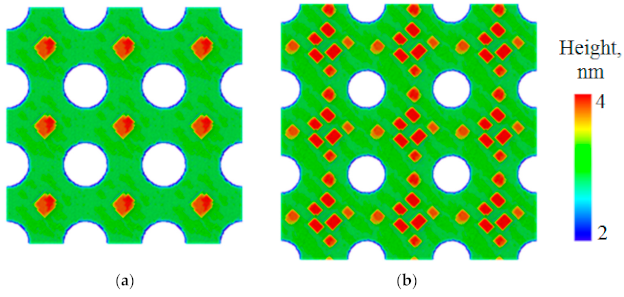

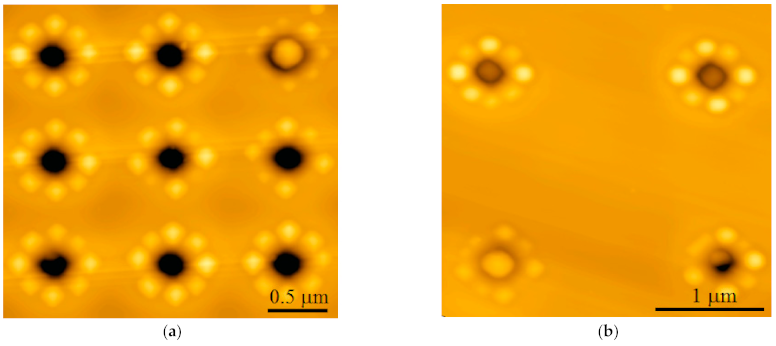
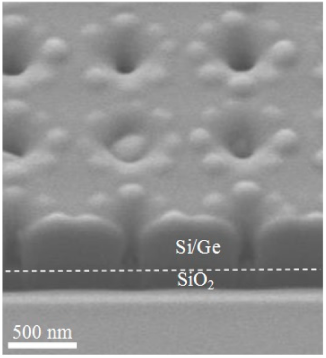
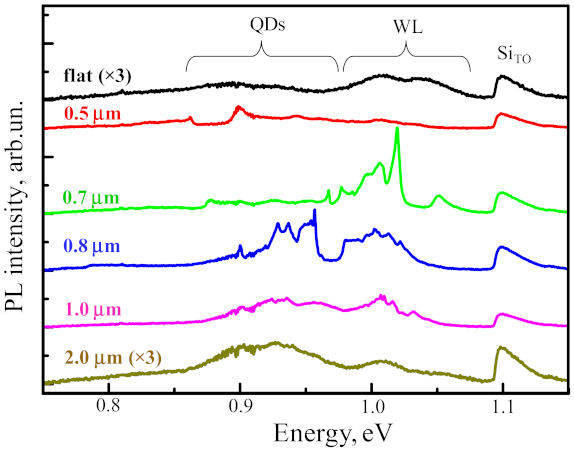
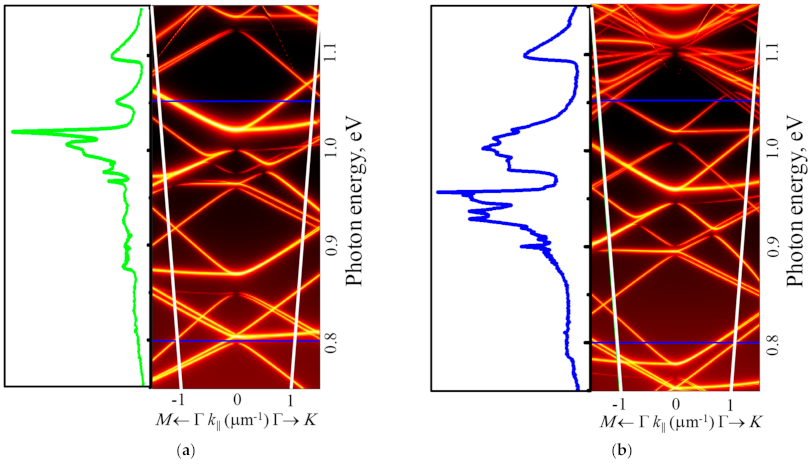
Publisher’s Note: MDPI stays neutral with regard to jurisdictional claims in published maps and institutional affiliations. |
© 2021 by the authors. Licensee MDPI, Basel, Switzerland. This article is an open access article distributed under the terms and conditions of the Creative Commons Attribution (CC BY) license (https://creativecommons.org/licenses/by/4.0/).
Share and Cite
Novikov, A.V.; Smagina, Z.V.; Stepikhova, M.V.; Zinovyev, V.A.; Rudin, S.A.; Dyakov, S.A.; Rodyakina, E.E.; Nenashev, A.V.; Sergeev, S.M.; Peretokin, A.V.; et al. One-Stage Formation of Two-Dimensional Photonic Crystal and Spatially Ordered Arrays of Self-Assembled Ge(Si) Nanoislandson Pit-Patterned Silicon-On-Insulator Substrate. Nanomaterials 2021, 11, 909. https://doi.org/10.3390/nano11040909
Novikov AV, Smagina ZV, Stepikhova MV, Zinovyev VA, Rudin SA, Dyakov SA, Rodyakina EE, Nenashev AV, Sergeev SM, Peretokin AV, et al. One-Stage Formation of Two-Dimensional Photonic Crystal and Spatially Ordered Arrays of Self-Assembled Ge(Si) Nanoislandson Pit-Patterned Silicon-On-Insulator Substrate. Nanomaterials. 2021; 11(4):909. https://doi.org/10.3390/nano11040909
Chicago/Turabian StyleNovikov, Alexey V., Zhanna V. Smagina, Margarita V. Stepikhova, Vladimir A. Zinovyev, Sergey A. Rudin, Sergey A. Dyakov, Ekaterina E. Rodyakina, Alexey V. Nenashev, Sergey M. Sergeev, Artem V. Peretokin, and et al. 2021. "One-Stage Formation of Two-Dimensional Photonic Crystal and Spatially Ordered Arrays of Self-Assembled Ge(Si) Nanoislandson Pit-Patterned Silicon-On-Insulator Substrate" Nanomaterials 11, no. 4: 909. https://doi.org/10.3390/nano11040909





